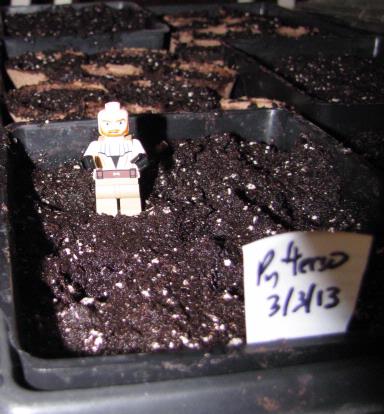A colleague of mine took some students out to the Montague Plains for a ramble recently. To demonstrate seed dispersal he picked up a pine cone and shook the seeds into his hand. Instead of seeds, he got a handful of springtails. As he tells the story, he didn’t miss a beat and told the surprised students that all the jumping is what helped pines spread so quickly.
I’m glad my garden seeds don’t jump to disperse because it gives me a chance to make sure each of them goes in the right place. This time, as you’ll see in the picture, I tried to recruit one of my children’s ninja minions as an assistant. He refused, spending his time perfecting something the boarders call “spinjitzu.” Somehow I don’t think this is a traditional Japanese art.
For the last decade or so I’ve started my seedlings in black plastic six pack containers. I seldom resist the urge to sow too many seeds, so if I don’t snip them off early, I wind up with spindly plants. Worse still, the close and tangled roots can lead to stressed plants.
This year I want to explore an idea I’ve been toying with for a while. Plants absorb most of the nutrients they need through single cell extensions from their roots that are about a hundredth of a millimeter thick called root hairs. During transplanting the soil disturbance rips the root hairs so the plants have to spend energy and time recovering rather than getting bigger.
Back in my first years of gardening I was susceptible to the amazing claims of self-sufficiency in gardening books. I was particularly doe-eyed about Eliot Coleman’s four season gardening. He recommends using a “soil-blocker.” This device, or really series of devices, compresses soil into little cubes with a hole in the top for the seed. Once the seedling gets a little large for its block, there is another block with a hole in it just big enough for block number one. Pretty cool. At no point do you have to rip roots apart.
But I am cheap and hate spending money. The next best thing, as I see it, is peat pots. With this year’s batch of onions, I’m going to conduct an experiment to see whether the no transplant idea actually grows better plants. I split my onion seeds among peat pots and standard six packs. I’ve mixed them up in flats so that all of the peat pots aren’t on one side. I’m hoping to continue the mixed spacing in the garden plot so that I can see if the planting style will make a difference.
But who am I kidding, I’m not going to resist. I’ve already put the blocking kit on my amazon wish list. I’m hoping maybe Oprah Winfrey will stumble upon my wish list and buy it for me.
A colleague of mine took some students out to the Montague Plains for a ramble recently. To demonstrate seed dispersal he picked up a pine cone and shook the seeds into his hand. Instead of seeds, he got a handful of springtails. As he tells the story, he didn’t miss a beat and told the surprised students that all the jumping is what helped pines spread so quickly.
I’m glad my garden seeds don’t jump to disperse because it gives me a chance to make sure each of them goes in the right place. This time, as you’ll see in the picture, I tried to recruit one of my children’s ninja minions as an assistant. He refused, spending his time perfecting something the boarders call “spinjitzu.” Somehow I don’t think this is a traditional Japanese art.

For the last decade or so I’ve started my seedlings in black plastic six pack containers. I seldom resist the urge to sow too many seeds, so if I don’t snip them off early, I wind up with spindly plants. Worse still, the close and tangled roots can lead to stressed plants.
This year I want to explore an idea I’ve been toying with for a while. Plants absorb most of the nutrients they need through single cell extensions from their roots that are about a hundredth of a millimeter thick called root hairs. During transplanting the soil disturbance rips the root hairs so the plants have to spend energy and time recovering rather than getting bigger.
Back in my first years of gardening I was susceptible to the amazing claims of self-sufficiency in gardening books. I was particularly doe-eyed about Eliot Coleman’s four season gardening. He recommends using a “soil-blocker.” This device, or really series of devices, compresses soil into little cubes with a hole in the top for the seed. Once the seedling gets a little large for its block, there is another block with a hole in it just big enough for block number one. Pretty cool. At no point do you have to rip roots apart.
But I am cheap and hate spending money. The next best thing, as I see it, is peat pots. With this year’s batch of onions, I’m going to conduct an experiment to see whether the no transplant idea actually grows better plants. I split my onion seeds among peat pots and standard six packs. I’ve mixed them up in flats so that all of the peat pots aren’t on one side. I’m hoping to continue the mixed spacing in the garden plot so that I can see if the planting style will make a difference.
But who am I kidding, I’m not going to resist. I’ve already put the blocking kit on my amazon wish list. I’m hoping maybe Oprah Winfrey will stumble upon my wish list and buy it for me.



